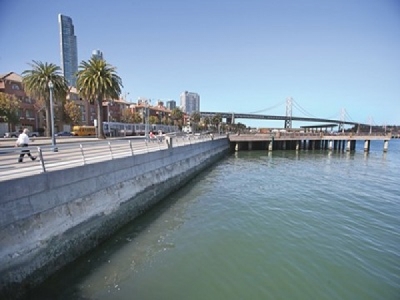
Posted on June 19, 2018
By Joshua Sabatini, SF Examiner
To shore up support for a more than $400 million bond proposal to repair San Francisco’s seawall, the Board of Supervisors on Tuesday added protections around historic resources and required more outreach to address construction impacts.
The board was poised to place the bond on the November ballot, but with the amendments is now expected to vote this week to place it on the ballot.
The $425 million seawall general obligation bond proposed by the Port of San Francisco would fund the first phase of the so-called seawall resiliency project. It requires two-thirds voter approval.
Supervisor Aaron Peskin said the amendments would help make the measure easier to pass by spelling out the city’s commitment to preserving historic asssets in the Embarcadero Historic District and reducing construction and traffic impacts downtown as much as possible while seismic upgrades to the seawall are underway.
The proposal is part of a larger 30 year, multi-billion dollar seawall project that would address both the risks of the seawall crumbling during a major earthquake and flooding from projected sea level rise.
“Ultimately [the bond] is a small piece of the overall need that we are going to have over the next several decades and we need to show the voters, if we are going to continue to come back to them with financing requests, that we are going to move forward rehabbing the seawall in a way that protects our historic resources with surgical precision,” Peskin said.
Meanwhile, House Minority Leader Nancy Pelosi (D-CA) announced that the U.S. Army Corps of Engineers has selected San Francisco’s waterfront for a feasibility study to determine how much federal funding it may provide to the seawall project, which could mean hundreds of millions of dollars.
The bond funding would pay for “the most urgent safety improvements” of the Embarcadero waterfront, including possibly strengthening the ground below the seawall, shoring up wharves and piers along the Embarcadero Promenade and relocating critical utilities, according to an April memo from Elaine Forbes, the Port of San Francisco’s executive director. The bond-funded work would extend to 2026.
Repayment of the bonds would cost $730.4 million with interest over 25 years, according to the budget analyst’s report. For property owners that means it would “require a property tax increase of approximately $13.23 per $100,000 of assessed value, per year, for 24 years,” according to the City Controller’s Office. Under the City’s Rent Ordinance, owners of rent-controlled apartments can pass 50 percent of any property tax increase on to tenants.
The City’s 10-year capital plan, overseen by City Administrator Naomi Kelly, states that “One of the top concerns to emerge from the City’s risk analyses in recent years is the vulnerability of the Seawall, which runs under the Embarcadero along the northern waterfront, roughly from Fisherman’s Wharf to AT&T Park.”
The seawall was built over a century ago to create “a deep water port in San Francisco,” Forbes’ memo said. “The seawall, which created over 500 acres of new land between San Francisco Bay and 1st Street, also sustains three miles of San Francisco waterfront, stretching from Fisherman’s Wharf to Mission Creek.”
The San Francisco Examiner previously reported in August that The City also needs to come up with $5 billion for the next phases in seawall work, which includes the potential replacement of the three-mile seawall to address both seismic concerns and sea-level rise. Climate change could cause the San Francisco Bay to rise by as much as 66 inches by 2100, according to city officials.
“The seawall serves as a critical area for emergency response and recovery and provides flood protection to downtown San Francisco,” Forbes’ memo said. “All told, the Seawall enables $24.6 billion of economic activity and protects $102.1 billion of property value.”
Source: SF Examiner





